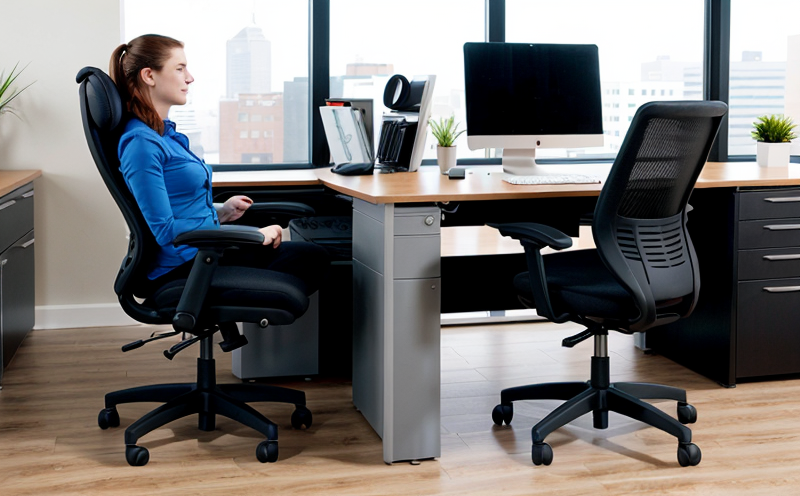ANSI BIFMA X7.1 Indoor Air Quality Emissions Testing of Office Furniture
The ANSI/BIFMA X7.1 standard is a benchmark in the furniture industry, ensuring that office furniture meets stringent requirements for indoor air quality emissions. This testing evaluates formaldehyde and other volatile organic compounds (VOCs) released by office furniture during use. The primary goal is to ensure that products are safe for human health, contributing significantly to a healthier indoor environment.
The X7.1 standard covers a wide range of office furniture types including chairs, desks, filing cabinets, and more. Testing begins with the selection of appropriate specimens that represent typical usage conditions in real-world environments. These specimens undergo rigorous testing procedures designed to mimic actual use scenarios, ensuring accurate emissions measurements. Specimens are placed inside climate-controlled chambers where controlled levels of humidity and temperature simulate office conditions.
The testing process involves continuous monitoring of air quality over a specified period, typically 96 hours for chairs and similar smaller items, and up to 208 hours for larger pieces like filing cabinets. During this time, sensors continuously measure the concentration of formaldehyde in parts per million (ppm). The standard specifies an acceptable limit of 0.1 ppm to ensure compliance.
After testing, detailed reports are generated that document emission levels and any deviations from the accepted limits. Compliance with ANSI/BIFMA X7.1 is critical for manufacturers aiming to meet regulatory requirements and maintain a reputation for producing high-quality, safe products. This certification also enhances consumer trust, especially in an era where indoor air quality is becoming more of a concern.
Compliance with this standard not only ensures legal compliance but also helps furniture manufacturers differentiate their products in the market. By adhering to X7.1 standards, companies can demonstrate their commitment to sustainability and health-conscious design, which is increasingly important for both end-users and regulatory bodies.
- Customer Impact: Compliance with ANSI/BIFMA X7.1 ensures a healthier indoor environment by minimizing the risk of adverse health effects from furniture emissions.
- Safety: By adhering to this standard, manufacturers can significantly reduce the likelihood of complaints and recalls due to non-compliance.
- Market Differentiation: Meeting these standards can give a manufacturer an edge over competitors, especially in health-conscious markets.
- Regulatory Compliance: Ensures adherence to international regulations promoting healthier indoor environments.
In summary, ANSI/BIFMA X7.1 testing is essential for manufacturers looking to produce safe and compliant office furniture. It plays a crucial role in maintaining high-quality standards that benefit both the manufacturer and end-user by ensuring a safer work environment.
Applied Standards
The ANSI/BIFMA X7.1 standard is one of several international standards used to ensure indoor air quality emissions from office furniture are safe for human health. It is particularly relevant in environments where prolonged exposure to certain chemicals can be detrimental, such as offices and other commercial spaces.
In addition to ANSI/BIFMA X7.1, other relevant standards include:
- ISO 16000-9:2015 - Guidelines for the Determination of Formaldehyde Emissions from Indoor Building Materials
- ASTM D6007-18: Standard Practice for Measuring Volatile Organic Compounds (VOCs) in Air from Furniture and Interior Finishes Using Ten-Box Adsorption Sampling System
- EN 438:2015 - Furniture - Determination of Formaldehyde Emissions from Solid Wood and Veneers
The ANSI/BIFMA X7.1 standard is specifically designed for office furniture, setting limits on formaldehyde emissions that are critical for maintaining a healthy indoor environment. By adhering to these standards, manufacturers can ensure their products meet the highest safety and quality benchmarks.
Frequently Asked Questions
Use Cases and Application Examples
The application of ANSI/BIFMA X7.1 testing extends across various sectors including office furniture manufacturing, healthcare facilities, educational institutions, and commercial buildings. This standard is particularly important in environments where prolonged periods of exposure to indoor air pollutants are common.
In the case of office furniture manufacturers, compliance with this standard ensures that their products meet strict emission limits, thereby promoting a safer work environment for employees. For healthcare facilities, ANSI/BIFMA X7.1 compliant furniture can contribute to better patient outcomes by minimizing exposure to harmful chemicals. Educational institutions benefit from reduced absenteeism and improved learning environments.
Commercial buildings, especially those targeting green or LEED certification, also prioritize compliance with this standard as part of their sustainability initiatives. By choosing ANSI/BIFMA X7.1 compliant furniture, these organizations can demonstrate their commitment to creating healthy indoor spaces that enhance the overall well-being of occupants.





